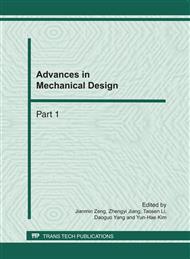p.700
p.707
p.715
p.721
p.729
p.734
p.739
p.745
p.749
Simulation on the Wear Behavior of the Wear-Resistant Surfaces Using Discrete Element Method
Abstract:
On the basis of the discrete element method (DEM), the non-linear mechanical model of the wear-resistant body surfaces was established. The step, convexity, and scale arranged structures of the wear-resistant surfaces and their abrasive wear systems were established with the software PFC2D®. Through the qualitative analysis on the morphology, the contact-bond fields and the contact-force chains, the minor injuries and the breakaway of the debris of the wear behaviors are observed. Besides, the dynamic force acted on the wear-resistant structures was studied through the quantitative analysis. Numeral simulation shows that the step structure was worn dramatically in its tip part, the convexity structure distributes the stress prominently and the scale structure shows the best wear-resistant function. The wear loss of the front monomers of the step, convexity, and scale structures are 2.43%, 2.02%, and 1.12% respectively after being worn for eight minutes in the simulation, which are in accordance with the experimental results. The numerical simulation on the abrasive wear behavior of the biological wear-resistant structures by DEM helps to reveal the wearable mechanism of the wear-resistant surfaces. Moreover, it provides a new method for studying the bionic wear-resistant surfaces and structures.
Info:
Periodical:
Pages:
729-733
Citation:
Online since:
February 2011
Authors:
Price:
Сopyright:
© 2011 Trans Tech Publications Ltd. All Rights Reserved
Share:
Citation:



